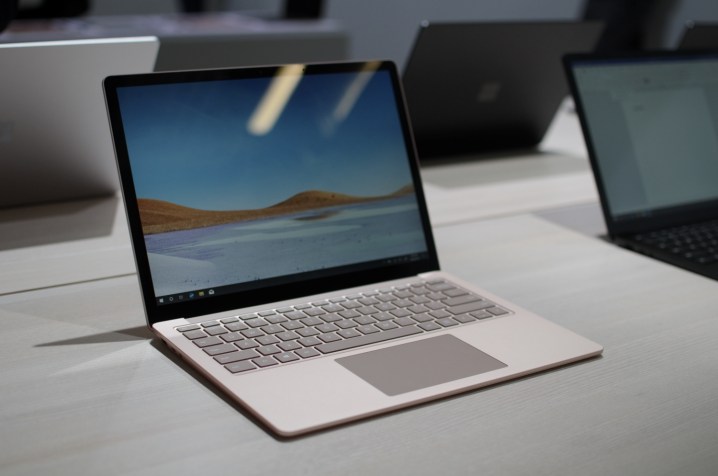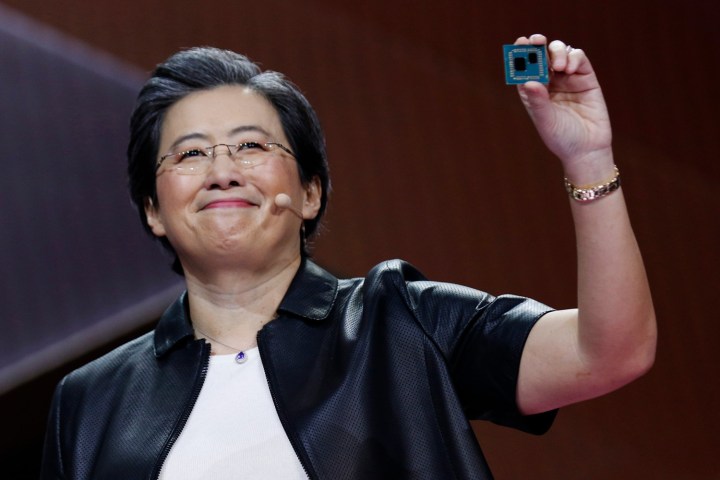Microsoft’s big Surface event in early October surprised everyone. Microsoft’s dual-screen devices were the star of the show, but the company’s new partnership with AMD on the Surface Laptop 3 felt downright subversive. It was the rumor that felt the most unlikely to come true.
But when we got our hands on the Surface Laptop 3’s AMD processor and put it through its paces, we were disappointed. It just can’t compete with the Intel competition, making us wish dearly that AMD would hurry up with its Zen 2 mobile CPUs.
Performance limitations
When Digital Trends visited the IFA 2019 show in Berlin this September, Intel told us that it described attempts from AMD and ARM to compete on mobile as “ridiculous.” It demonstrated a number of tasks between comparable Intel and AMD mobile CPUs, the result of which (as you might expect from a first-party demonstration) was that Intel came out ahead.
Partisan promotional showings might not hold much value on their own. Bu when combined with independent testing like our time with the Surface Laptop 3, we begrudgingly have to agree.

We loved the Surface Laptop 3’s excellent build quality, great keyboard and touchpad, and the much-belated addition of USB-C. But there are some major shortfalls and one of the most glaring of them is performance. It’s “fine,” as our reviewer Luke Larsen put it, roughly comparable to that of an eighth-generation Core i5 Intel CPU. That’s not exactly a fitting chip for a 15-inch laptop that should have a bit more muscle. That’s especially when the AMD Ryzen 5 CPU at the heart of the Surface Laptop 3 has been chosen over the far more capable Intel 10th-generation Ice Lake range that are available in the 13-inch version.
It’s a disappointing note on what has been an otherwise stellar year for AMD.
The Ryzen 7 option is more capable, but due to the way Microsoft has configured the Surface Laptop 3 options, you’d need to spend at least $2,100 to get it. And you’d still only get four cores for your trouble. An XPS 15 specced to cost much the same, would give you a six-core CPU and an Nvidia GTX 1650 for additional graphical power.
That’s not say that the Ryzen chips don’t have some advantages. They have been slightly tweaked to Microsoft’s specification and have even been named “Ryzen Surface Edition” to make that clear. The Ryzen 5 3580U and Ryzen 7 3780U come with one additional graphics core than the non-Surface Edition Ryzen counterparts (Ryzen 5 3500U and Ryzen 7 3700U) and a slightly higher GPU clock speed in the case of the Ryzen 5. But that’s hardly enough to warrant choosing this chip over the Intel Ice Lake alternative. Especially when Ice Lake 11th-generation graphics are very competitive with AMD’s Vega cores.

This represents a disappointing note on what has been an otherwise stellar year for AMD. Its Ryzen 3000 desktop processors, launched in July, have become some of our favorite chips. With fantastic multi-threaded and single-core performance, they go toe-o-toe with Intel’s best, and in many cases outstrip the blue team’s competition.
So why, if AMD is doing so well elsewhere, is its mobile chips not able to hold up its end of the bargain? Because they’re still living in the past.
Desktop-first
Where Intel tends to release its mobile CPUs first (and only, if we’re talking 10nm) AMD does things the other way around. It releases its flagship architectures on desktop first, followed by mobile variants the following year. That’s why Ryzen 3000 mobile CPUs are so underwhelming compared to their desktop counterparts. In reality, they’re Ryzen 2000 CPUs.
Ryzen 3000 mobile chips like the 3780U and 3580U, are based on the Zen+ core of Ryzen 2000 desktop chips. They’re great CPUs, but they’re outdated. It’s hard to justify their inclusion in the Surface Laptop 3, which will undoubtedly be compared to powerful laptops like the Dell XPS 15 and MacBook Pro.
If this was AMD’s effort to lay the groundwork for Zen 2’s eventual debut on mobile (the latest hint was a CES 2020 debut in January) and show people that AMD is a viable option on laptops, but the 15-inch Surface Laptop 3 may have been a false start. The timing just wasn’t right.

Of course, the partnership does gets AMD in the door at Microsoft for future Surface collaborations. The fact that the CPU at the heart of the Surface Laptop 3 is customized for Microsoft is intriguing, and holds potential for new, more bespoke designs in the future. But when, in this case, it only involved slight improvements to graphical power, we’ll need to see a lot more before we’re impressed with that arrangement.
With the leaps and bounds AMD has made in its CPU division in recent years, we are cautiously optimistic that once Zen 2 makes its way to AMD mobile CPUs, we’ll be able to much more readily recommend AMD-powered laptops outside of entry-level hardware. Especially if they integrate well with the new, incoming Navi 5500m mobile graphics chip.
Intel has famously dropped the ball on its own 10nm developments, allowing AMD to catch up. That’s not the case in the mobile space. Its new Ice Lake CPUs are excellent. Its sequel, Tiger Lake, is on track and on form to improve things further, with Intel’s hotly anticipated 12th-generation, Xe graphics.
AMD still has a lot to prove with its Zen 2 mobile chips, but here’s to hoping this isn’t the last Surface partnership we’ve seen.
Editors' Recommendations
- CES 2023: AMD Ryzen 7000 laptops CPUs go up to 16 cores
- Upcoming AMD Ryzen 7000 CPU outperforms Zen 3 by up to 40%
- AMD’s Zen 3+ CPUs are great, so why is no one using them?
- AMD drops six new chips, reveals price of 3D V-Cache chip
- New AMD Zen 3 CPUs may challenge Intel while we await Zen 4





